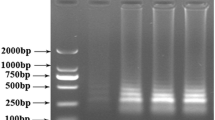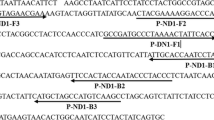Abstract
A simple, sensitive, specific and fast method based on the loop-mediated isothermal amplification (LAMP) technique and cleavable molecular beacon (CMB) was developed for chicken authentication detection. LAMP and CMB were used for DNA amplification and amplicon analysis, respectively. Targeting the mitochondrial cytochrome b gene of chickens, five primers and one CMB probe were designed, and their specificity was validated against nine other animal species. The structure of CMB and concentrations of dNTPs, MgSO4, betaine, RNase H2, primers and CMB were optimized. The CMB-LAMP assay was completed within 17 min, and its limit of detection for chicken DNA was 1.5 pg μL−1. Chicken adulteration as low as 0.5% was detected in beef, and no cross-reactivity was observed. Finally, this assay was successfully applied to 20 commercial meat products. When combined with our developed DNA extraction method (the extraction time was 1 min: lysis for 10 s, washing for 20 s and elution for 30 s), the entire process (from DNA extraction to results analysis) was able to be completed within 20 min, which is at least 10 min shorter than other LAMP-based methods. Our method showed great potential for the on-site detection of chicken adulteration in meat.
Graphical abstract




Similar content being viewed by others
References
Godfray HCJ, Aveyard P, Garnett T, Hall JW, Key TJ, Lorimer J, Pierrehumbert RT, Scarborough P, Springmann M, Jebb SA. Meat consumption, health, and the environment. Science. 2018;361(6399). https://doi.org/10.1126/science.aam5324.
Mounika T, Girish PS, Shashi Kumar M, Kumari A, Singh S, Karabasanavar NS. Identification of sheep (Ovis aries) meat by alkaline lysis-loop mediated isothermal amplification technique targeting mitochondrial D-loop region. J Food Sci Technol-Mysore. 2021;58(10):3825–34. https://doi.org/10.1007/s13197-020-04843-2.
Roy S, Abd Rahman I, Santos JH, Ahmed MU. Meat species identification using DNA-redox electrostatic interactions and non-specific adsorption on graphene biochips. Food Control. 2016;61:70–8. https://doi.org/10.1016/j.foodcont.2015.09.029.
Hossain MAM, Uddin SMK, Sultana S, Bonny SQ, Khan MF, Chowdhury ZZ, Johan MR, Ali ME. Heptaplex Polymerase Chain Reaction Assay for the Simultaneous Detection of Beef, Buffalo, Chicken, Cat, Dog, Pork, and Fish in Raw and Heat-Treated Food Products. J Agric Food Chem. 2019;67(29):8268–78. https://doi.org/10.1021/acs.jafc.9b02518.
Abbas O, Zadravec M, Baeten V, Mikus T, Lesic T, Vulic A, Prpic J, Jemersic L, Pleadin J. Analytical methods used for the authentication of food of animal origin. Food Chem. 2018;246:6–17. https://doi.org/10.1016/j.foodchem.2017.11.007.
Hu X, Xu H, Zhang Y, Lu X, Yang Q, Zhang W. Saltatory rolling circle amplification (SRCA) for sensitive visual detection of horsemeat adulteration in beef products. Eur Food Res Technol. 2021;247(11):2667–76. https://doi.org/10.1007/s00217-021-03720-2.
Zhao L, Wang K, Yan C, Xiao J, Wu H, Zhang H, Zhang X, Zhang C, Hu Y, Lu X, Zheng W. A PCR-based lateral flow assay for the detection of Turkey ingredient in food products. Food Control. 2020;107. https://doi.org/10.1016/j.foodcont.2019.106774.
Sezer B, Bjelak A, Velioglu HM, Boyaci IH. Identification of meat species in processed meat products by using protein based laser induced breakdown spectroscopy assay. Food Chem. 2022;372. https://doi.org/10.1016/j.foodchem.2021.131245.
Stachniuk A, Sumara A, Montowska M, Fornal E. Liquid chromatography-mass spectrometry bottom-up proteomic methods in animal species analysis of processed meat for food authentication and the detection of adulterations. Mass Spectrom Rev. 2021;40(1):3–30. https://doi.org/10.1002/mas.21605.
Zhang M, Li Y, Zhang Y, Kang C, Zhao W, Ren N, Guo W, Wang S. Rapid LC-MS/MS method for the detection of seven animal species in meat products. Food Chem. 2022;371. https://doi.org/10.1016/j.foodchem.2021.131075.
Zia Q, Alawami M, Mokhtar NFK, Nhari RMHR, Hanish I. Current analytical methods for porcine identification in meat and meat products. Food Chem. 2020;324. https://doi.org/10.1016/j.foodchem.2020.126664.
Yin R, Sun Y, Wang K, Feng N, Zhang H, Xiao M. Development of a PCR-based lateral flow strip assay for the simple, rapid, and accurate detection of pork in meat and meat products. Food Chem. 2020;318. https://doi.org/10.1016/j.foodchem.2020.126541.
Kumar Y. Isothermal amplification-based methods for assessment of microbiological safety and authenticity of meat and meat products. Food Control. 2021;121. https://doi.org/10.1016/j.foodcont.2020.107679.
Kumar Y, Narsaiah K. Rapid point-of-care testing methods/devices for meat species identification: A review. Compr Rev Food Sci Food Saf. 2021;20(1):900–23. https://doi.org/10.1111/1541-4337.12674.
Nguyen HA, Lee NY. Polydopamine aggregation: A novel strategy for power-free readout of loop-mediated isothermal amplification integrated into a paper device for multiplex pathogens detection. Biosens Bioelectron. 2021;189. https://doi.org/10.1016/j.bios.2021.113353.
Lo Y-T, Shaw P-C. DNA-based techniques for authentication of processed food and food supplements. Food Chem. 2018;240:767–74. https://doi.org/10.1016/j.foodchem.2017.08.022.
Quembo CJ, Jori F, Vosloo W, Heath L. Genetic characterization of African swine fever virus isolates from soft ticks at the wildlife/domestic interface in Mozambique and identification of a novel genotype. Transbound Emerg Dis. 2018;65(2):420–31. https://doi.org/10.1111/tbed.12700.
Shehata HR, Li J, Chen S, Redda H, Cheng S, Tabujara N, Li H, Warriner K, Hanner R. Droplet digital polymerase chain reaction (ddPCR) assays integrated with an internal control for quantification of bovine, porcine, chicken and turkey species in food and feed. PLoS One. 2017;12(8). https://doi.org/10.1371/journal.pone.0182872.
Girish PS, Barbuddhe SB, Kumari A, Rawool DB, Karabasanavar NS, Muthukumar M, Vaithiyanathan S. Rapid detection of pork using alkaline lysis- Loop Mediated Isothermal Amplification (AL-LAMP) technique. Food Control. 2020;110. https://doi.org/10.1016/j.foodcont.2019.107015.
Notomi T, Okayama H, Masubuchi H, Yonekawa T, Watanabe K, Amino N, Hase T. Loop-mediated isothermal amplification of DNA. Nucleic Acids Res. 2000;28(12). https://doi.org/10.1093/nar/28.12.e63.
Viet Loan Dao T, Herbst K, Boerner K, Meurer M, Kremer LPM, Kirrmaier D, Freistaedter A, Papagiannidis D, Galmozzi C, Stanifer ML, Boulant S, Klein S, Chlanda P, Khalid D, Miranda IB, Schnitzler P, Kraeusslich H-G, Knop M, Anders S. A colorimetric RT-LAMP assay and LAMP-sequencing for detecting SARS-CoV-2 RNA in clinical samples. Sci Transl Med. 2020;12(556). https://doi.org/10.1126/scitranslmed.abc7075.
Notomi T, Mori Y, Tomita N, Kanda H. Loop-mediated isothermal amplification (LAMP): principle, features, and future prospects. J Microbiol. 2015;53(1):1–5. https://doi.org/10.1007/s12275-015-4656-9.
Cai S, Kong F, Xu S. Detection of porcine-derived ingredients from adulterated meat based on real-time loop-mediated isothermal amplification. Mol Cell Probes. 2020;53. https://doi.org/10.1016/j.mcp.2020.101609.
Shi Y, Feng Y, Xu C, Xu Z, Cheng D, Lu Y. Loop-Mediated Isothermal Amplification Assays for the Rapid Identification of Duck-Derived Ingredients in Adulterated Meat. Food Anal Methods. 2017;10(7):2325–31. https://doi.org/10.1007/s12161-016-0767-0.
Tyagi S, Kramer FR. Molecular beacons: Probes that fluoresce upon hybridization. Nat Biotechnol. 1996;14(3):303–8. https://doi.org/10.1038/nbt0396-303.
Varona M, Eitzmann DR, Anderson JL. Sequence-Specific Detection of ORF1a, BRAF, and ompW DNA Sequences with Loop Mediated Isothermal Amplification on Lateral Flow Immunoassay Strips Enabled by Molecular Beacons. Anal Chem. 2021;93(9):4149–53. https://doi.org/10.1021/acs.analchem.0c05355.
Bakthavathsalam P, Longatte G, Jensen SO, Manefield M, Gooding JJ. Locked nucleic acid molecular beacon for multiplex detection of loop mediated isothermal amplification. Sens Actuators B-Chem. 2018;268:255–63. https://doi.org/10.1016/j.snb.2018.04.081.
Varona M, Anderson JL. Visual Detection of Single-Nucleotide Polymorphisms Using Molecular Beacon Loop-Mediated Isothermal Amplification with Centrifuge-Free DNA Extraction. Anal Chem. 2019;91(11):6991–5. https://doi.org/10.1021/acs.analchem.9b01762.
Han Y, Zhang F, Gong H, Cai C. Functional three helix molecular beacon fluorescent “turn-on” probe for simple and sensitive simultaneous detection of two HIV DNAs. Sensors Actuators B Chem. 2019;281:303–10. https://doi.org/10.1016/j.snb.2018.10.110.
Liu W, Huang S, Liu N, Dong D, Yang Z, Tang Y, Ma W, He X, Ao D, Xu Y, Zou D, Huang L. Establishment of an accurate and fast detection method using molecular beacons in loop-mediated isothermal amplification assay. Sci Rep. 2017;7. https://doi.org/10.1038/srep40125.
Ding X, Yin K, Chen J, Wang K, Liu C. A ribonuclease-dependent cleavable beacon primer triggering DNA amplification for single nucleotide mutation detection with ultrahigh sensitivity and selectivity. Chem Commun. 2019;55(84):12623–6. https://doi.org/10.1039/c9cc06296c.
Varona M, Anderson JL. Advances in Mutation Detection Using Loop-Mediated Isothermal Amplification. Acs Omega. 2021;6(5):3463–9. https://doi.org/10.1021/acsomega.0c06093.
Su Y, Huang S, Hong L, Zou D, Tang Y, Chao S, He X, Xu Y, Liu X, Li L, Feng L, Li W, Liu W, Ke Y, Huang L. Establishment of the molecular beacon-loop-mediated isothermal amplification method for the rapid detection of Porphyromonas gingivalis. J Microbiol Methods. 2019;160:68–72. https://doi.org/10.1016/j.mimet.2019.01.013.
Ding X, Yin K, Li Z, Pandian V, Smyth JA, Helal Z, Liu C. Cleavable hairpin beacon-enhanced fluorescence detection of nucleic acid isothermal amplification and smartphone-based readout. Sci Rep. 2020;10(1). https://doi.org/10.1038/s41598-020-75795-y.
Aparin IO, Sergeeva OV, Mishin AS, Khaydukov EV, Korshun VA, Zatsepin TS. Excimer-FRET Cascade in Dual DNA Probes: Open Access to Large Stokes Shift, Enhanced Acceptor Light up, and Robust RNA Sensing. Anal Chem. 2020;92(10):7028–36. https://doi.org/10.1021/acs.analchem.0c00270.
Varona M, Eitzmann DR, Pagariya D, Anand RK, Anderson JL. Solid-Phase Microextraction Enables Isolation of BRAF V600E Circulating Tumor DNA from Human Plasma for Detection with a Molecular Beacon Loop-Mediated Isothermal Amplification Assay. Anal Chem. 2020;92(4):3346–53. https://doi.org/10.1021/acs.analchem.9b05323.
Ang YS, Yung L-YL. Rational design of hybridization chain reaction monomers for robust signal amplification. Chem Commun. 2016;52(22):4219–22. https://doi.org/10.1039/c5cc08907g.
Barratt K, Mackay JF. Improving real-time PCR genotyping assays by asymmetric amplification. J Clin Microbiol. 2002;40(4):1571–2. https://doi.org/10.1128/JCM.40.4.1571-1572.2002.
Burdukiewicz M, Spiess AN, Blagodatskikh KA, Lehmann W, Schierack P, Rodiger S. Algorithms for automated detection of hook effect-bearing amplification curves. Biomol Detect Quantif. 2018;16:1–4. https://doi.org/10.1016/j.bdq.2018.08.001.
Wang F, Wu X, Xu D, Chen L, Ji L. Identification of Chicken-Derived Ingredients as Adulterants Using Loop-Mediated Isothermal Amplification. J Food Prot. 2020;83(7):1175–80. https://doi.org/10.4315/JFP-19-542.
Kesmen Z, Yetiman AE, Sahin F, Yetim H. Detection of Chicken and Turkey Meat in Meat Mixtures by Using Real-Time PCR Assays. J Food Sci. 2012;77(2):C167–73. https://doi.org/10.1111/j.1750-3841.2011.02536.x.
Lin L, Zheng Y, Huang H, Zhuang F, Chen H, Zha G, Yang P, Wang Z, Kong M, Wei H, Zou X, Lin M. A visual method to detect meat adulteration by recombinase polymerase amplification combined with lateral flow dipstick. Food Chem. 2021;354:129526. https://doi.org/10.1016/j.foodchem.2021.129526.
Prachugsorn A, Thanakiatkrai P, Phooplub K, Ouiganon S, Sriaead Y, Thavarungkul P, Kanatharana P, Buranachai C, Kitpipit T. Detection of porcine DNA in food using direct asymmetric PCR and catalyzed hairpin assembly fluorescent biosensor: A novel assay for halal food analysis. Food Control. 2022;139. https://doi.org/10.1016/j.foodcont.2022.108989.
Yan C, Wang X, Zhao X, Wei M, Shi C, Ma C. Development of a direct and visual isothermal method for meat adulteration detection in low resource settings. Food Chem. 2020;319:126542. https://doi.org/10.1016/j.foodchem.2020.126542.
Acknowledgments
The National Natural Science Foundation of China (No. 32102060), Key R&D Program of Zhejiang (Nos. 2021C02059-4 and 2022C02028), Natural Science Foundation of Zhejiang Province (No. LQ21B050003), Science and Technology Programs of Ningbo (Nos. 202003N4127 and 20211ZDYF020179) and State Key Laboratory for Managing Biotic and Chemical Threats to the Quality and Safety of Agro-products (No. 2021DG700024-KF202112) are gratefully acknowledged for financial support.
Author information
Authors and Affiliations
Corresponding authors
Ethics declarations
Conflict of interest
The authors declare no conflicts of interest.
Additional information
Publisher’s note
Springer Nature remains neutral with regard to jurisdictional claims in published maps and institutional affiliations.
Supplementary information
ESM 1
(DOC 2299 kb)
Rights and permissions
Springer Nature or its licensor holds exclusive rights to this article under a publishing agreement with the author(s) or other rightsholder(s); author self-archiving of the accepted manuscript version of this article is solely governed by the terms of such publishing agreement and applicable law.
About this article
Cite this article
Yan, S., Lan, H., Wu, Z. et al. Cleavable molecular beacon-based loop-mediated isothermal amplification assay for the detection of adulterated chicken in meat. Anal Bioanal Chem 414, 8081–8091 (2022). https://doi.org/10.1007/s00216-022-04342-7
Received:
Revised:
Accepted:
Published:
Issue Date:
DOI: https://doi.org/10.1007/s00216-022-04342-7




